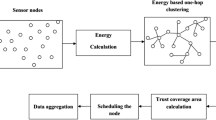Abstract
Area coverage is an important issue in wireless sensor networks, which reflects how well an area is monitored or tracked by sensors. But, since a sensor network has restricted energy resources, energy efficiency is vital for this area coverage. One of the most efficient solutions to provide energy-aware area coverage is scheduling. That is, without any assumption about sensors’ locations, only a distributed and parallel scheduling method determines which sensors should be on and which ones should be off in each decision period. The ultimate objective is to maximize network lifetime and keeping a target level of area coverage. A major part of the algorithms proposed in this field, schedule a sensor node activity based on its neighbors’ information. Such information includes the distances of a node from its neighbors, the number of its active neighbors, etc. Indeed, message exchange is essential in the implementation of these algorithms which causes to increased energy consumption. In this paper, we propose a distributed scheduling algorithm, at which, each node itself decides to make its sensor on or off based on its location information and the node density over the target area. For this purpose, we first compute the minimum number of nodes that are enough to cover the target area. Then we obtain the best locations for theses nodes. Based on these computed location the area is partitioned into some sub-area, each one coverable by only one sensor. Then in each sub-area, a local scheduling procedure schedules the activation order of sensor. Simulation results show that the proposed algorithm, called CAOP, can maximize the network lifetime while maintaining complete area coverage.






Similar content being viewed by others
References
Rault, T., Bouabdallah, A., & Challa, Y. (2014). Energy efficiency in wireless sensor networks: A top-down survey. Computer Networks, 67, 104–122.
Rizvi, S., Qureshi, H. K., Ali Khayam, S., Rakocevic, V., & Rajarajan, M. (2012). An energy efficient topology control algorithm for connected area coverage in wireless sensor networks. Journal of Network and Computer Applications, 35(2), 597–605.
Zhang, Z. L., Li, D., Huang, T. P., & Cui, L. (2013). Leveraging data fusion to improve barrier coverage in wireless sensor networks. The Journal of China Universities of Posts and Telecommunications (Elsevier), 20(1), 26–36.
Yang, S., Dai, F., Cardei, M., Wu, J., & Patterson, F. (2006). On connected multiple point coverage in wireless sensor networks. International Journal of Wireless Information Networks, 13, 289–301.
Abdesslem, F. B., Phillips, A., & Henderson T. (2009). Energy efficient mobile sensing with SenseLess. In The 1st ACM Workshop on Networking, Systems, and Applications for Mobile Handhelds, Barcelona, Spain (pp. 61–62).
Wu, T. T., & Ssu, K. F. (2005). Determining active sensor nodes for complete coverage without location information. International Journal of Ad Hoc and Ubiquitous Computing, 1, 38–46.
Wang, G., Cao, G., Berman, P., & Porta, T. F. L. (2007). Bidding protocols for deploying mobile sensors. IEEE Transactions on Mobile Computing, 6(5), 515–528.
Chen, C., Chuang, C. L., Lin, T. S., Lee, C., & Jiang, J. A. (2010). A coverage-guaranteed algorithm to improve network lifetime of wireless sensor networks. Eurosensor XXIV Conference (Elsevier), 5, 192–195.
Ye, F., Zhong, G., Cheng, J., Lu, S., & Zhang, L. (2003). PEAS: A robust energy conserving protocol for long-lived sensor networks. In The 23rd international conference on distributed computing systems (ICDCS), USA (pp. 28–37).
Keskin, M. E., Altınel, I. K., Aras, N., & Ersoy, C. (2014). Wireless sensor network lifetime maximization by optimal sensor deployment, activity scheduling, data routing and sink mobility. Ad Hoc Networks (Elsevier), 17, 18–36.
Alonso, J. M., Voigt, T., & Varshney, A. (2013). Bounds on the lifetime of WSNs. In IEEE 9th international conference on distributed computing in sensor systems (DCoSS 2013) (pp. 367–373).
Noori, M., & Ardakani, M. (2011). Lifetime analysis of random event-driven clustered wireless sensor networks. IEEE Transactions on Mobile Computing, 10(10), 1448–1458.
Bai, H., Chen, X., Li, B., & Han, D. (2007). A location-free algorithm of energy-efficient connected coverage for high density wireless sensor networks. Discrete Event Dynamic Systems (Springer), 17(1), 1–21.
Zhang, L. J., & Wang, H. C. (2011). Energy saving with node sleep and power control mechanisms for wireless sensor networks. The Journal of China Universities of Posts and Telecommunications (Elsevier), 18, 49–59.
Pan, L., & Li, J. (2010). K-nearest neighbor based missing data estimation algorithm in wireless sensor networks. Wireless Sensor Network, 2(2), 115–122.
Wang, C. F., & Lee, C. C. (2010). The optimization of sensor relocation in wireless mobile sensor networks. Computer Communications (Elsevier), 33, 828–840.
Ölveczky, P. C., & Thorvaldsen, S. (2007). Formal modeling and analysis of the OGDC wireless sensor network algorithm in real-time Maude (FMOODS). In The 9th IFIP WG 6.1 international conference on Formal methods for open object-based distributed systems (Springer) (pp. 122–140).
Banimelhem, O., Mowafi, M., & Aljoby, W. (2013). Genetic algorithm based node deployment in hybrid wireless sensor networks. Communications and Network, 5(4), 273–279.
Wang, X., & Wang, S. (2011). Hierarchical deployment optimization for wireless sensor networks. IEEE Transactions on Mobile Computing, 10(7), 1028–1041.
Network simulator. www.isi.edu/nsnam/ns
Mahjria, I., Dhraiefa, A., Mabroukia, I., Belghitha, A., & Drirab, K. (2014). The coverage configuration protocol under at-dist localization. In The 5th international conference on ambient systems, networks and technologies (ANT-2014), Procedia Computer Science (Vol. 32, pp. 141–148).
Author information
Authors and Affiliations
Corresponding author
Rights and permissions
About this article
Cite this article
Jamali, S., Hatami, M. Coverage Aware Scheduling in Wireless Sensor Networks: An Optimal Placement Approach. Wireless Pers Commun 85, 1689–1699 (2015). https://doi.org/10.1007/s11277-015-2862-8
Published:
Issue Date:
DOI: https://doi.org/10.1007/s11277-015-2862-8




